Cruising on Seventh Heaven
The last 30 days,
Years
2006,
2007,
2008,
2009,
2010,
2011,
2012,
2013 or
view the entire archive.
|
hello world01 Jan 2009:
The New Year.
Between Christmas and New Year we just relaxed and got to know the other yachties in the marina many were from past rallies that were still here enjoying this part of the world. We provisioned with all the luxury items cheese, dried tomatoes, olives, meat etc. and stocked up on duty free grog.
One evening we had a kalie (Scottish sing a long) where the yachties from all over the world either sang, played a musical instrument or recited poetry our contribution was a rendition of ‘Aussie Jingle Bells’ backed by some talented musicians.
New Years Eve
The venue for our New Years Eve bash was the Hard Dock Café at Rebak marina where one hundred yachties enjoyed a Thai smorgasbord and danced to music from our very talented DJ until the early hours.
Photos
Gill (Destiny III) and Betty
Trevor & Joan (Beenalong) dancing the night away
|
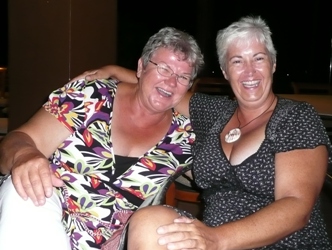
+ Click to enlarge
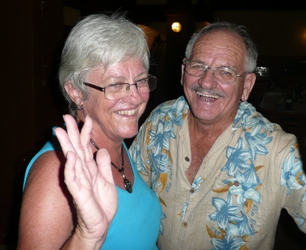
+ Click to enlarge
|
08 Jan 2009:
Thailand here we come.
We left Rebak marina on New Years Day heading for the tourist island of Phuket in Thailand anchoring along the way at Ko Lipe a small layback resort island, Ko Rok and Phi Phi Don. We anchored in Ao Chalong a large protected bay on the southeast end of Phuket where customs and immigration are located. This is where most yachts check in and out of east Thailand and provision so there is always many yachts anchored off. It is also a very busy tourist port where charter boats of all descriptions embark on day trips to the outer islands and Phang Nga Bay.
Our first visitor had arrived to stay with us. This was Johnny’s first stop on a 60 day round the world adventure. (See Dot Com Cruising left hand menu).
We sailed out to Phi Phi Le famous as the setting for the movie ‘The Beach’ and arrived just as the day trippers were leaving. Anchored in Maya Bay surrounded by soaring limestone cliffs and sparkling water we went for a snorkel then watched the sunset over a beer. Johnny is in seventh heaven.
Next morning it was over to Phi Phi Don the most popular tourist island in the region. The island was badly damaged in the 2004 tsunami and many lives were lost but after undergoing a massive rebuilding program Phi Phi Don is quickly returning to its pre tsunami days. The anchorage in Ton Sai Bay is protected buy huge limestone cliffs with fringing coral reef and clear water but unfortunately it is also full of tourist boats. There are resorts spread around the foreshore and the village is a hub of activity with its narrow streets full of vendors, souvenir shops, dive shops, restaurants and backpacker bungalows.
Our next anchorage was Ko Racha Yai in a beautiful bay with crystal clear water fringing coral reef and fine white sandy beach. At the head of the bay was a local restaurant on the rocks and a five star boutique resort. I don’t think Johnny wants to leave.
Photos
Longtail Maya Bay Phi Phi Le
Ton Sai Bay Phi Phi Don
Johnny and Betty – Restaurant on the rocks Ko Racha Yai.
P.S.
We hired a Sunsail yacht out of Phuket with our friends Bob and Lesley in March 2003 and it was pleasing to see that the area has recovered from the devastating tsunami of 2004. The tourist are returning, Phi Phi Don has been rebuilt and is much cleaner and has a better infrastructure in place and our favorite little restaurant on the rocks at Ko Racha Yai has survived.
|

+ Click to enlarge

+ Click to enlarge
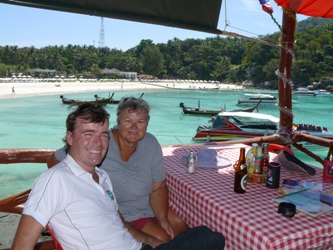
+ Click to enlarge
|
25 Jan 2009:
Our visit up to Phuket was very short mostly taken up with Johnny’s visit and a wonderful six days R & R at Luguna Holiday Club Resort on Bang Tao Beach with Dave and Pattie off ‘This Way Up’.
We anchored our boats off the beach in front of the resort and just spent the time lazing around the pool, walking along the beach and enjoying lovely sunset dinners at the local alfresco restaurants on the beach. A nice change after being on ‘Seventh Heaven’ for the last nine months.
Photos:
Alfresco dinning on Bang Tao Beach with Pattie, Dave and Johnny.
Luguna Holiday Club Resort
|
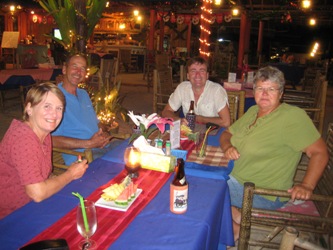
+ Click to enlarge
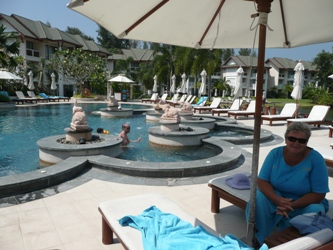
+ Click to enlarge
|
02 Feb 2009:
Visit Home
Charlie and I returned to Australia early February as we were going to be grandparents. Kathryn and Ken were due to have a baby girl (well Kath was).
We were met by Ken and Kath at 8am, blurry-eyed and tired at the Gold Coast airport after having traveled for sixteen hours by ferry boat, taxi, and plane from Rebak Island Langkawi to Gold Coast.
Straight away it was off to breakfast – real bacon and eggs, real bread, real cappuccinos – expensive after the cheapness of Asia, but after the last eight months of living without these, it was truly wonderful.
Though we spent most of our time on the Gold Coast we did get to Mackay in a whirlwind trip to attend Greg Tobin’s 50th birthday party. It was like a grand reunion of the crew that did the Sydney to Hobart on 'Dehler Magic' and the old 'Taminda' days. A very big night was had by all, though Greg and Sandy (Greg’s wife) really did not appreciate Charlie sleeping with them. We also made time to get our taxes done and visit our financial planner (not that he could give us any startling news or ideas).
Emma came down from Townsville to escape the wet and to celebrate her 27th Birthday with us on the Gold Coast. We had home cooked lamb roast with all the trimmings and Baskin Robin ice-cream cake.
Photos:
Greg's 50th The 'Taminda' Boys
Emma's 27th
|
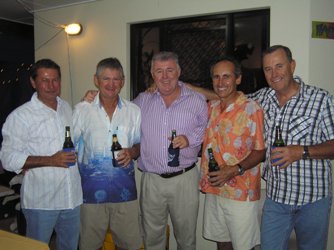
+ Click to enlarge
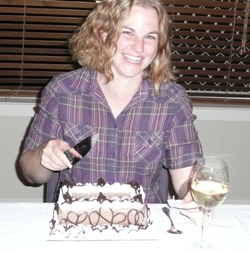
+ Click to enlarge
|
19 Feb 2009:
19th February 2009
Mia’s Birthday
We all rose at 4.30am and had coffee as Kathryn couldn’t sleep, her admission for an induction was for 6.30am. As the day progressed Kathryn’s labour was not going quite to plan so after sixteen hours it was off to surgery for a caesarean. All went very well and Mia was born at 10.50 pm (2250 for us yachties) weighed in at 9lb 8oz (4.32kg) and was 20.3” (51.5cm) long.
Within half an hour of Mia being born we were able to play Granny and Granddad what a special moment.
Photos:
A little miracle
Granny and Mia
Mia’s web site www.miaogilvie.com
|
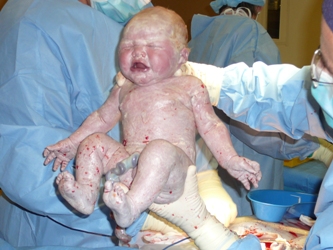
+ Click to enlarge
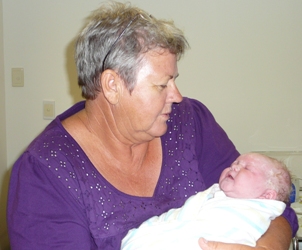
+ Click to enlarge

+ Click to enlarge
|
31 Mar 2009:
Our stay on the Gold Coast was longer than anticipated due to Kathryn’s recovery time but it gave us lots of time with Mia. During this time we visited my sister Rose at Nanago and I spent a few days with Emma in Brisbane who had returned from Townsville with glandular fever meanwhile Charlie kept himself occupied unit hunting (we decided to purchase a unit on the Gold Coast as we will be spending more time there in the future). We found a nice two bedroom holiday unit at Burleigh Heads 100 meters from the beach with unlimited owners use plus we could leave the car there while we were away. We have already booked the unit for Christmas and New Year.
We managed to get up to Airlie for the last week of our visit home and spent some time with friends sharing our adventures.
Photos:
More Mia Time
Our new Gold Coast unit
|
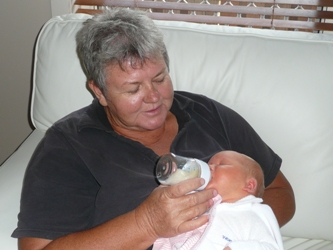
+ Click to enlarge
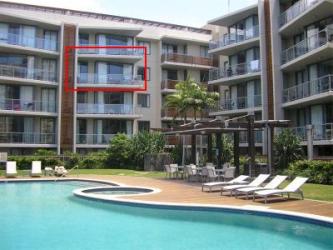
+ Click to enlarge
|
26 Jun 2009:
Phuket Revisited
After retuning from our visit home we cruised from Langkawi to Phuket in company with Warwick and Maryon on ‘Nimbus II’ exploring the various island anchorages along the way including Koh Muk which has an amazing cathedral like hong 60m in diameter known as the Emerald Cave accessed by dinghy through a 80m long dark cave.
A hong (Thai for room) is like a hole in the island open to the sky accessible by a cave.
Arriving in Phuket we spent the first two weeks in Boat Lagoon Marina having our radar and genset repaired. The genset had a burnt out exhaust valve. The head and block were removed then the head was machined and new valve fitted the cylinder honed and reassembled for a total price of $320 Aust.
We also took advantage of this time to explore Phuket Island which is only 50 klm long and 25 klm wide and has a population of 85000 people. We visited the tourist destinations along the west coast with white sandy beaches crammed with hotels and condominiums, bars, restaurants and souvenir shops. To the east lies Old Phuket Town with its narrow streets full of old shuttered two storey specialty shop houses, interesting people and cheap and cheerful Thai restaurants serving excellent food which is in contrast to the centre of the island where you will find modern shopping malls, supermarkets and home improvement centres similar to Australia.
Leaving the marina we had a month cruising the emerald green waters of picturesque Phang Nga Bay that has a landscape like no other. The scenery is spectacular with rugged rainforest covered limestone islands concealing many hongs, caves and creeks to explore. Most of the islands are uninhabited except for a few small fishing villages whose fishermen always have fresh prawns to trade.
Photos
Inside the Emerald Cave Koh Muk (entrance behind dinghy)
Anchored at Phi Phi Lei
Limestone overhangs Phang Nga Bay
|

+ Click to enlarge
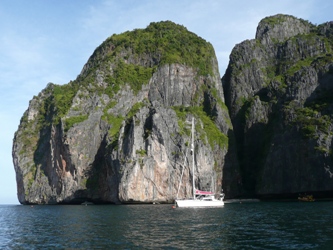
+ Click to enlarge
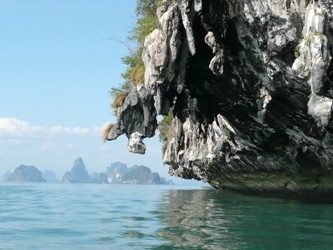
+ Click to enlarge
|
27 Jun 2009:
Emma’s Visit.
In June we had the pleasure of a visit from our daughter Emma.
We had a berth at Ao Po Grand Marina so Emma could have a good nights rest in air conditioning after her flight from Australia. In hindsight this was a wise decision as we had strong winds and continuous rain the next two days then the weather cleared giving us ten days of perfect conditions.
We sailed up to Phang Nga Bay exploring the caves and hongs of Koh Phanak and Koh Hong then up to Koh Pan Yai to the Muslim fishing village on stilts. Here we hired a longtail ( Narrow wooden boat about 10m long with long propeller shaft extending from large pivoting engine mounted on the stern ) and traveled along the many mangrove lined waterways which harbour many marine species, reptiles, birds and monkeys. We passed through natural limestone arches full of stalactites and saw cave paintings that are said to be 3000 years old that were similar to aboriginal cave paintings. On our way to nearby Koh Phing Kan (James Bond Island) we were hit by a squall which tipped the longtail on its side. With the crew (that would be us) quickly moving to the high side the boat eventually came upright and our skipper wasting no time headed straight for a small beach. After the squall had past and our nerves had settled we left the sanctuary of our little beach and continued on to James Bond Island where the 1974 movie ‘The Man with a Golden Gun’ was filmed. This once idyllic little island is now a major tourist attraction with boats coming and going all day and the beach full of souvenir vendors. We finished the day off with a late lunch of BBQ and deep fried chilli fish selected from their farm at one of the excellent seafood restaurants at the Muslim fishing village.
Photos:
Emma and Betty at James Bond Island.
Muslim fishing village.
Our longtail passing through limestone arch.
|
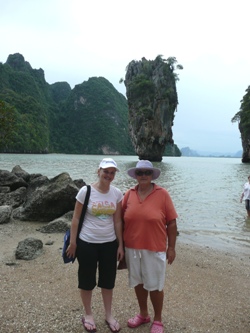
+ Click to enlarge
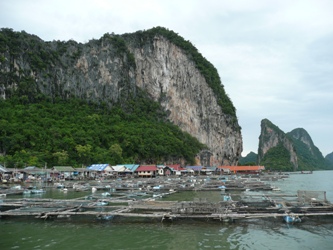
+ Click to enlarge
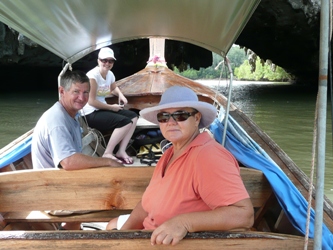
+ Click to enlarge
|
28 Jun 2009:
The next two nights we slowed down the pace anchoring on the east side of Koh Yao Noi with a day sail to Koh Pak Bia and Koh Hong (Krabi) were we enjoyed some snorkeling.
We had a lovely sail down to Koh Phi Phi Don where again we hired a longtail to explore the crystal clear waters and white sandy beaches of Koh Phi Phi Le.
Our final destination was Ao Chalong at the south eastern end of Phuket were we hired a car a did the tourist dive around the island, checked out the night life at Patong the bars, go go girls and much more, sampled the best of Thai food and went to Phuket Fantasea a Thai theme park with a theater that holds 4000 people. This production was world class and this magical show captured the colour and pageantry of traditional Thai dance and costumes combined with a magnificent light and sound show and at times there were up to twenty elephants performing on stage.
Exhausted and bubbling from her Thai experience it was time for Emma to return to Australia and for us to head back to Langkawi to start our next adventure.
Photos:
Emma and us at The Natural restaurant Old Phuket Town
Emma playing with the elephants
|
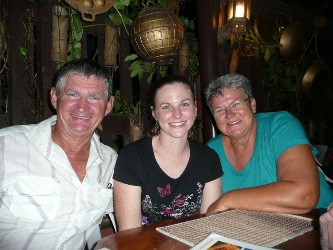
+ Click to enlarge
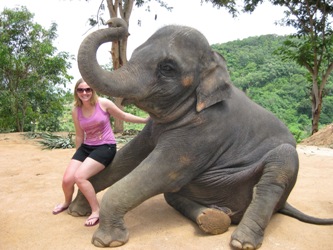
+ Click to enlarge
|
05 Jul 2009:
Northern Thailand
Chiang Mai
Together with Warwick and Maryon we boarded our Air Asia flight bound for Chiang Mai.
Chiang Mai is located in a beautiful valley surrounded mystical mountains and although the second largest city in Thailand only has a population of just over 200000.
Chiang Mai is a unique blend of old and new. The quaint old moated and walled city with its markets, traditional shop houses and Wats (Buddhist temples) is in contrast surrounded by high rise office buildings, modern hotels and shopping complexes.
We stayed at the Parosol Inn in the heart of the old city from here we roamed around the streets taking in the sights, enjoying the night markets and local food.
Chiang Mai with more than 300 Wats dating back as far as 1296 is definitely the city of temples. We visited many of these Wats all architecturally slightly different depending on the period of construction with elaborate murals on the walls depicting popular Thai stories and religious events not to mention the amazing Buddha images.
The most sacred of these temples is Wat Phra That Doi Suthep built in 1383 on top of a mountain overlooking the city. At the end of the road up the mountain a staircase of 306 steps leads up to the Wat and 79 feet high Golden Chedi (conical Buddhist monument used to inter sacred objects).
Chiang Mai is also renowned for its arts and crafts, woodcarving, lacquer ware, rattan, silverwork and bronze castings.
We visited a Thai silk factory where we were shown the process from silk worm to extraordinary garments and an umbrella village where they make hand painted paper umbrellas using pulped mulberry tree bark to produce the paper and the wood for the frames that are exported world wide.
Photos
Buddha Statues - Wat Phra That Doi Suthep
Golden Chedi - Wat Phra That Doi Suthep
Paper Umbrella Making
|

+ Click to enlarge
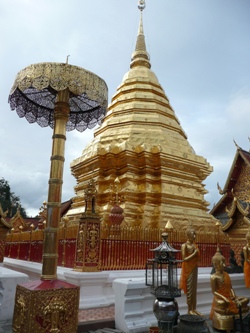
+ Click to enlarge

+ Click to enlarge
|
06 Jul 2009:
Day Tripping
From Chiang Mai we did a day trip up to Tha Ton on the border of Thailand and Myanmar (Burma) high in the mountains to visit some of the hill tribes that live in this area.
The hill tribe people are ethnic minorities that have come from Tibet, Myanmar, China and Laos during the past 200 years. They have crossed borders into Thailand fleeing oppression and are basically refugees lacking Thai citizenship. They live in small villages on the mountain sloops in houses built of wood and bamboo with thatched grass roofs growing rice, corn and opium and making handicrafts.
There are ten known hill tribes with an estimated population of 550000 which have their individual language, customs and spiritual beliefs. We visited the village of an Akha tribe and a Karen tribe.
The Akha tribe originated from Tibet and the women can be easily identified by their colourful headdress of beads, feathers and dangling silver ornaments also their teeth are usually black from chewing beetle nut.
The Karen longneck tribe originated from Myanmar and the women wear a continuous coil made of solid brass around their neck which rarely comes off. These coils are fitted to girls at about age six and consist of four of five coils being added to each year until adulthood when the coil weighs approx 5kg and has twenty six coils.
The coils depress the collarbone and ribcage which makes their neck look elongated. The origin of the coils is unsure some say it was to make women unattractive to men from other tribes or to protect their throats from tiger attacks.
I must admit that when we first arrived at the village we felt as though these women were being exploited but after spending some time with these softly spoken gentle people and learning about their lives you came to accept their customs.
Photos
Akha Woman
Karen Longneck Woman
Karen Longneck Girl with Betty
|
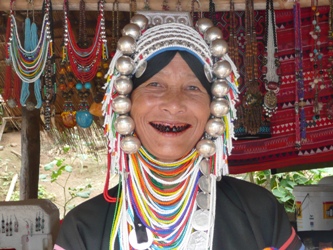
+ Click to enlarge
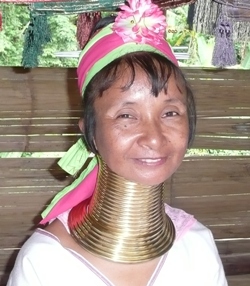
+ Click to enlarge
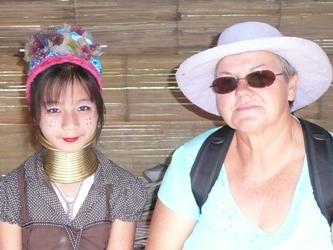
+ Click to enlarge
|
07 Jul 2009:
Chiang Rai
Chiang Rai is 180 klm north of Chiang Mai a 3˝ hour scenic bus trip through mountain ranges and fertile rural flood plains of the Mekong River.
Chiang Rai though much smaller than Chiang Mai still had many interesting sights. In the past Chiang Rai was the centre of the opium trade in Thailand commonly known as the ‘Golden Triangle’ but today due to tougher law enforcement this trade has all but ceased.
We traveled north to Doi Tung (Doi means mountain) where at the summit (1420 m) is Wat Phra That Doi Tung and two golden Chedi built in 911 great views or so they say as unfortunately on the day of our visit the summit was cloud covered. On the slopes of Doi Tung is the Royal Villa built by the late Princess Mother (the Kings mother). The Princess Mother spent many years living in Switzerland where her children were educated and the villa is built from local timber in the architectural style of a Swiss chalet. It is now open to the public as a museum. Adjacent to the Royal Villa is the Mae Fah Luang Gardens which even on a cloudy and rainy day were spectacular.
Photos
Mae Fah Luang Gardens
Keeping dry on a rainy day
|
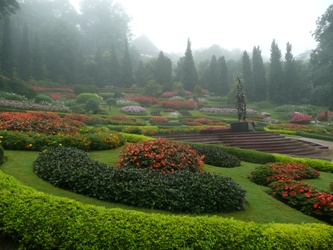
+ Click to enlarge
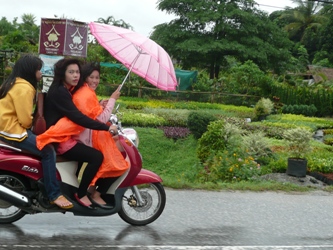
+ Click to enlarge
|
08 Jul 2009:
South of Chaing Rai we visited the unusual Wat Rong Khun. Known as the ‘White Wat’ construction began in 1997 and is still continuing. The exterior is painted completely white and is decorated with millions of small mirror chips. Beneath the entrance bridge to the Wat is a sculpture of reaching arms symbolising a desire to enter the sanctity of the Wat. Inside the murals on the walls depict contemporary themes such as jet planes crashing into the twin towers and space ships exploding quite bizarre.
The night markets had an interesting local food hall with all sorts of exoctic dishes. Warwick and I sampled some old time favorites roast pig intestines which were rather tasty and deep fried crickets, silk worms and bamboo worms which supposedly high in protein tasted like crunchy french fries.
Photos
Wat Rong Khun
Sculpture of Reaching Arms
A tasty feast of crickets and worms
|
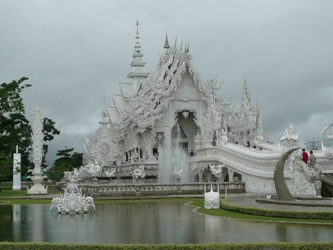
+ Click to enlarge

+ Click to enlarge
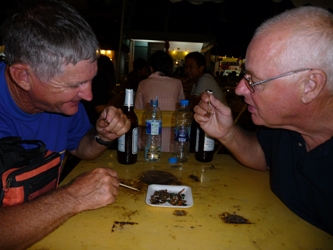
+ Click to enlarge
|
09 Jul 2009:
Chiang Saen
We boarded a local bus for the 1˝ hour trip north to Chiang Saen traveling through the fertile rice producing flood plains of the Mekong River.
Chiang Saen is a small boarder town located on the west bank of the Mekong River and in the 14th century was an important Thai kingdom. Within the walled city there are many ruins of wats and chedi that have survived.
Today it is a busy port for river barges importing goods from China and a border crossing for Thai and Lao nationals.
Our hotel was inside the old walled city from where we strolled around the ruins and checked out the delicacies at the local market.
We caught a sawngthaew (small open mini bus) to Sop Ruak 10 km north where the Nam Ruak River and Mekong River converge creating the boarders between Myanmar, Thailand and Laos and is the tourist centre of the Golden Triangle. Here we visited the House of Opium museum displaying the history and culture of opium.
Photos:
Sop Ruak – Golden Triangle
BBQ catfish for lunch
Wat Chedi Luang built 1291 AD
|
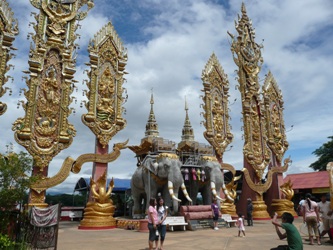
+ Click to enlarge
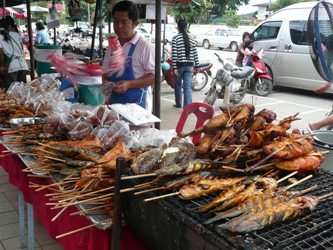
+ Click to enlarge

+ Click to enlarge
|
10 Jul 2009:
Chiang Khong
We hired a sawngthaew for the 52 km trip over the mountains to Chiang Khong.
Apart from nearly being asphyxiated by the dust and diesel fumes I am sure our driver had aspirations to be a rally driver.
Chiang Khong a small border town on the Mekong River is the legal border crossing from Thailand to Laos and a market town for local hill tribes and trade from northern Laos.
We stayed in a comfortable and friendly traditional Thai guesthouse (more like a tree house) complete with chooks, cats and dogs overlooking the river.
Next morning we boarded a small river boat and crossed the river into Laos.
Photos
Our Guesthouse on the banks of the Mekong River
Crossing the river to Laos
|
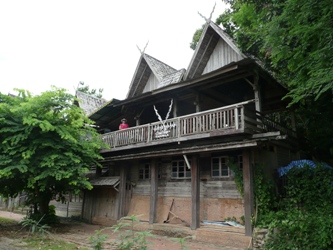
+ Click to enlarge
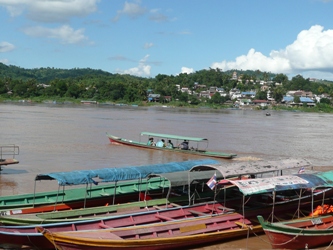
+ Click to enlarge
|
11 Jul 2009:
Laos
Laos is a small landlocked country with a population of 5.6 million bordered by China, Myanmar (Burma), Thailand, Cambodia and Vietnam.
Laos was a French colony from 1893 to 1953 when it was granted independence and much of the French influence remains. In 1975 after the fall of South Vietnam the communist Lao People’s Democratic Republic Party was formed which saw the end of the 650 year old monarchy and the royal family imprisoned to work in the fields.
Although Laos is a communist country people can farm their own land and private enterprise is permitted mainly to encourage foreign investment.
Huay Xai
Our trip across the Mekong River to Huay Xai took about five minutes. Immigration and customs were located at the boat landing which issued visas on arrival for US$20.
Huay Xai is another small bustling river trading port with Thailand and China. The town centre above the boat landing extends for only a few hundred meters consisting of mainly guest houses.
After checking in to our guest house we strolled down the main street where we found that the most popular commodity was snake wine. Now I don’t mind a drink but there are some limits so unfortunately I cannot tell you what it tastes like.
Photos
Snake Wine and Whisky
Huay Xai
|
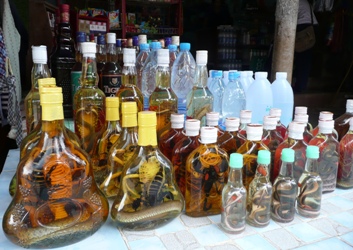
+ Click to enlarge
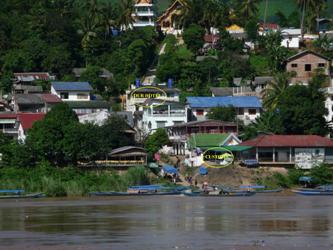
+ Click to enlarge
|
12 Jul 2009:
Down the Mighty Mekong
The Mekong River is 4180 kilometers long and is the 10th longest river in the world. Its source is high in the Tibetan plateau and it flows south through China, Myanmar, Thailand, Laos, Cambodia and Vietnam empting into the South China Sea.
The Mekong River flows 1865 kilometers through Laos and is the natural boundary for most of the country to the west and the artery of life for those who live along its banks.
At Huay Xai we boarded a 34 meter Mekong river boat for a two day 160 kilometer cruise down river to Luang Prabang this was a package that included all meals and two nights accommodation and cost 147 euros per person. Our boat was up market and well appointed with lounge chair seating, bar and galley with only 20 passengers and 8 crew including guide and chef. The local boats carry in excess of 100 passengers seated on wooden bench seats.You can also travel by speed boat but the fatality rate is high.
Photos:
Our Mekong river boat
Charlie and Warwick relaxing down the river
Mekong river speed boat fare includes helmet
|
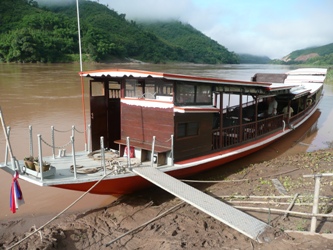
+ Click to enlarge
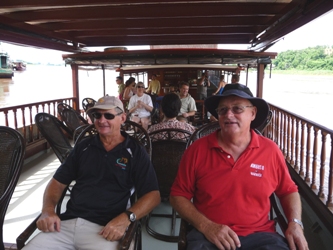
+ Click to enlarge

+ Click to enlarge
|
13 Jul 2009:
The Mekong River between Huay Xai and Luang Prabang is only about 500 meters wide and runs at around 5 knots and with many rocky outcrops swirling eddies and over falls made the trip quite exciting.
The river winds its way through jungle covered mountains, teak plantations and hillside farmland with villages dotted along its banks.
We visited two villages along the way and experienced their day to day life planting rice, tending water buffalo used for ploughing, preparing meals and distilling rice whisky. They must wonder why we find their way of life so interesting as they know nothing of ours.
Along the banks were people fishing in small canoes others panning for gold and elephants extracting timber from the forest.
The river can only be navigated during daylight hours and our overnight destination was Pakbeng a small river town consisting mainly of guest houses and eateries catering for the large number of river travelers. We stayed at the Luang Say Lodge built in traditional Laotian style of solid timber over looking the river and backed by rain forest. From the veranda of our modern bungalow we could watch the river go by and listen to the sounds of the forest.
Next day further down river we explored the Tham Ting (caves of a thousand Buddha’s) which is dedicated to the sprits of the river and is a Buddhist temple.
Arriving in Luang Prabang late afternoon we made our way to the Villa Maly for a quite drink and swim in the pool.
What a glorious two days and totally recommended.
Photos:
Village children
Buddhist Monk
River children improvising
Footnote
Eco friendly Betty with her trusty can of mortein that she never leaves home without managed to kill off half the insect population at our lodge at Pakbeng.
|
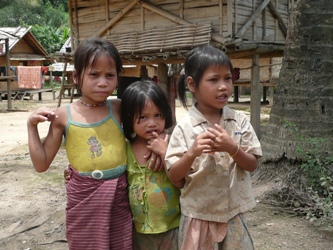
+ Click to enlarge
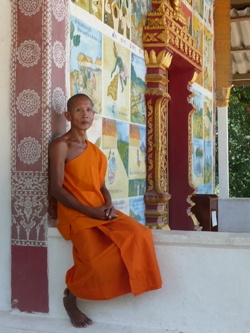
+ Click to enlarge

+ Click to enlarge
|
14 Jul 2009:
Luang Prabang lies at the confluence of the Mekong and Nam Khan Rivers and is surrounded by majestically mountain ranges.
Once the Royal capital of Laos it has many ancient and beautiful Buddhist temples throughout the town where each morning hundreds of monks from the various monasteries walk through the streets collecting alms. Along with the magnificent wats a part of the old town's appeal are the many French provincial style houses of which many have been converted into hotels.
The town was great to explore on foot with its narrow street and lanes revealing many handicraft shops, galleries and good restaurants. One of the major landmarks in the town is Mount Phousi. Here you can climb the 328 steps up to Wat Chom Si where there are splendid views of the area.
The Royal Palace is now an excellent museum and also in the grounds is the Royal theatre where we enjoyed a local performance. The story line given to us in an English program made it easy to follow.
At night the town comes to life the main street is cut off to traffic and the night markets are set up stretching for a kilometre selling all sorts of handicrafts, textiles and clothing. The night food stalls have cheap and tasty tucker such as noodle soup, BBQ chicken and fish, salads and fresh fruit. For the more adventurous there was treats such as BBQ intestines, private parts, little baby birds and others unknowns.
Nowadays we rarely party on and are usually early to bed just as well as the town has a 11.30pm curfew and lights out by midnight.
Photos:
Hmong Handicraft Shop.
Theatre Performers.
Warwick enjoyig some street food.
|
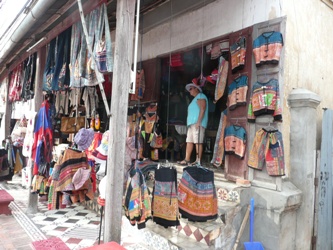
+ Click to enlarge
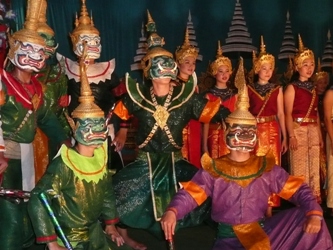
+ Click to enlarge
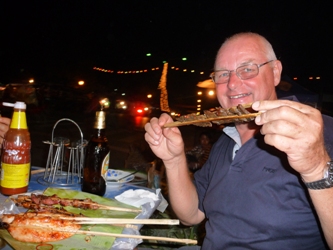
+ Click to enlarge
|
15 Jul 2009:
Laos was once known as ‘The Land of a Million Elephants’ but today they are an endangered species with only about 1600 remaining.
The elephant village and sanctuary on the Nam Khan River near Luang Prabang rescues working and logging elephants from their harsh and abusive environments giving them a new home and brighter future.
These gentle giants are the largest land animals and live for 60 years weigh 3 to 5 tons and are 2 to 3 meters high and eat a massive 200 kg of food per day.
During our two days at the village we spent many hours with the elephants and their handlers (mahouts) learning about them.
On the first day we were shown how to mount and ride the elephants both in a Howdah (saddle) and on their necks and were taught the basic commands though I don’t think the elephants understood our accent.
During the afternoon we rode the elephants up into the forest where they spent the night roaming for food. We then trekked back to the village and went for a short boat trip up river to the beautiful Tad Sae falls with its many pools to cool off and relax a wonderful way to end the day. That evening we stayed at their lodge and had dinner at the restaurant overlooking the river to the mountains complete with a beautiful rainbow.
Early morning we trekked back up into the forest and rode the elephants down to the river for a swim. We gave them a good scrubbing with a stiff brush which they seemed to enjoy immensely. After our fun in the river we rode back to the village where the elephants were prepared for the next group of tourist to enjoy these wonderous animals.
After saying goodbye to the elephants we kayaked down the Nam Khan River back to Liang Prabang passing through natural forest areas and farmland. The river was flowing at about two knots making paddling easy and negotiating the small rapids was exhilarating.
Photos
View from the Lodge
Time for a good scrub
Betty going for a ride
|
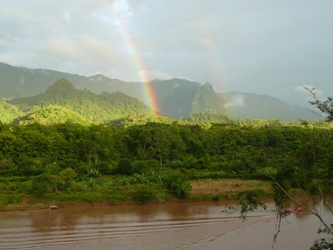
+ Click to enlarge
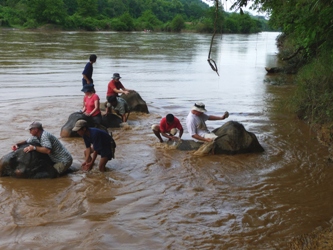
+ Click to enlarge
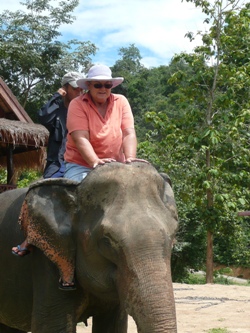
+ Click to enlarge
|
16 Jul 2009:
From Luang Prabang we hired a mini van with driver and guide and made way to Phonsavan to visit the Plain of Jars. The 8 hour 270 kilometer trip wound its way through rugged mountain ranges with breathtaking scenery and sometimes breathtaking hillside roads.
On the way we stopped to explore the Tham Pha Caves where several hundred local people took refuge during the Indochina war. Still remaining in the network of caverns are remnants of the hospital and a large Buddha sits just inside the main entrance.
Photo:
The road to Phonsavan
|
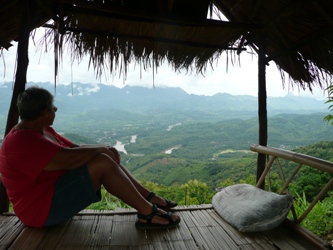
+ Click to enlarge
|
17 Jul 2009:
Phonsavan is the capital of the Xieng Khuang province located on a mountainous plateau in the north east of Laos.
This province was devastated during the Indochina war between 1964 and 1973 during which time the original capital Xieng Khuang was almost totally destroyed by heavy bombing.
More than 2 million tones of ordnance were dropped on Laos giving it the distinction of the most heavily bombed nation in the world.
This conflict has left a deadly legacy that will remain for generations as approximately 30% of these ordnances did not explode and are still lethal. Unexploded ordnances (UXO’s) litter the country side causing land deprivation, accidental injuries and death. The Lao National UXO Programme is working hard to educate people and clear these UXO’s but this will take many more years.
The Plain of Jars extending around Phonsavan is dotted with large carved stone jars weighing between 600 and 6000kg and said to be 2500 years old. The origin of these jars is unknown though some archeologists believe they are funeral urns. Unfortunately archeological digs at these sites are too dangerous due to UXO’s.
Even though Phonsavan is off the beaten track there is plenty to see. The UXO visitor centre run by the Mines Advisory Group (MAG) showed quite graphically the damage resulting from war and how they were helping people rebuild their lives. At the Mulberry silk farm we learnt how they dye silk using local plants and the produce market had lots of interesting delicacies such as rat, guinea pig and mole type creatures. For us our staple diet was noodle soup with who knows what the ingredients were but tasty just the same.
Photos:
Left over ordnance
One of the larger Jars
Plain of Jars note bomb crater in centre of photo.
|
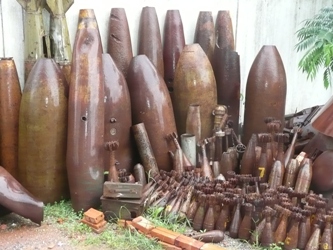
+ Click to enlarge
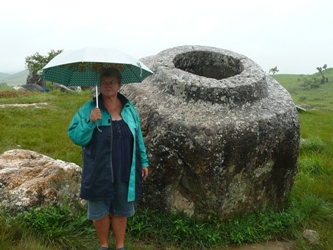
+ Click to enlarge
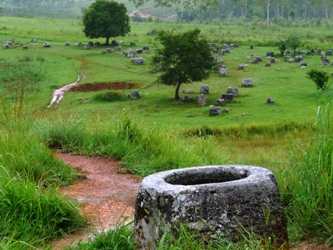
+ Click to enlarge
|
19 Jul 2009:
We continued our trip through the mountains down to Vientiane on the Mekong River the capitol of Laos. Vientiane is more like a large country town than a city with not a great deal of traffic and wide streets.
The days were very hot so we only visited a few of the sights.
Pha Lhat Luang a Buddhist temple which is the most important national monument in Laos, the Lao National Museum which is more like a revolutionary museum mainly about the Pathet Lao and their struggle for power, Xieng Khuan (Buddha Park) filled with bizarre concrete sculptures and the Friendship Bridge built across the Mekong River to Thailand in 1994. The cost was $30 million funded by the Australian government and built by Australian companies.
One thing Vientiane is noted for is it has great cheap restaurants both local and international so after many days surviving on noodle soup it was a nice change to sample some French and Italian dishes.
Photos:
Pha Lhat Luang
Xieng Khuan (Buddha Park)
|
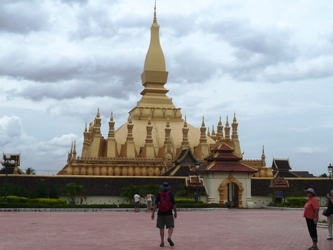
+ Click to enlarge
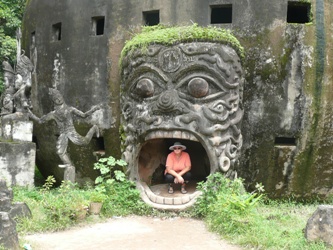
+ Click to enlarge
|
|
|
|
 The
Cruising Adventures of Seventh Heaven with Charlie and Betty
The
Cruising Adventures of Seventh Heaven with Charlie and Betty The
Cruising Adventures of Seventh Heaven with Charlie and Betty
The
Cruising Adventures of Seventh Heaven with Charlie and Betty